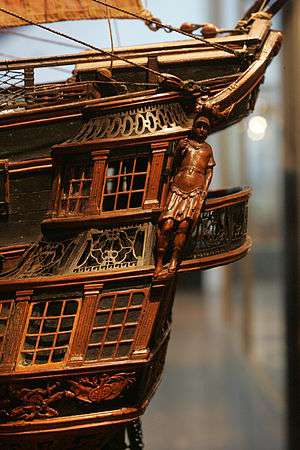French ship Artésien
 Model on display at the Musée de la Marine | |
| History | |
|---|---|
| Namesake: | Artois |
| Builder: | Joseph Ollivier |
| Laid down: | Brest, 1764 |
| Launched: | 1765 |
| Out of service: | 1785 |
| Fate: | Engineering hulk |
| General characteristics | |
| Class and type: | Artésien class ship of the line |
| Displacement: | 1260 tonnes |
| Length: | 47 m (154 ft) |
| Beam: | 12 m (39 ft) |
| Draught: | 6 m (20 ft) |
| Armament: |
|
| Armour: | timber |
The Artésien (“Artesian”) was a 64-gun ship of the line of the French Navy, lead ship of her class. She was funded by a don des vaisseaux donation from the Estates of Artois.
Artésien was built in 1765 as a part of a series of 12 ships of the line began by Choiseul to compensate for the losses endured by the French Royal Navy during the Seven Years' War.[1] She was paid by the province of Artois and Flander, and named in its honour, according to the practice of the time.[2]
The Artésien took part in the American revolutionary war under Suffren, departing in 1781. Off Cape Verde, Artésien detected an English squadron, resulting in the Battle of Porto Praya.[3]
Artésien was decommissioned in 1785 and used as a shear hulk.
A fine 1/28th scale model was used to instruct Louis XVI in naval studies. The model is now on display at the Musée de la Marine.
Notes and references
| Wikimedia Commons has media related to Artésien (ship, 1765). |
- ↑ (French) Archéologie et modélisme d'arsenal
- ↑ (French) Mon carnet de Bretagne
- ↑ (French) Liste des régiments et vaisseaux. Théatre d'opérations : Etats-Unis 1777-1782
- Jean Boudriot, L'Artésien, vaisseau de 64 canons 1762-1785 Neptunia Vol. 36, Paris, 1981, p. 143
- Jean Boudriot & Hubert Berti, Les vaisseaux de 50 & 64 canons 1650 - 1780, éditions Ancre
- (French)
- (French)